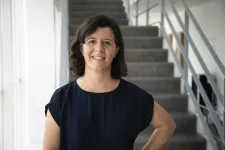(Press-News.org) AI is so energy hungry that most data analysis must be performed in the cloud
New energy-efficient device enables AI tasks to be performed within wearables
This allows real-time analysis and diagnostics for faster medical interventions
Researchers tested the device by classifying 10,000 electrocardiogram samples
The device successfully identified six types of heart beats with 95% accuracy
EVANSTON, Ill. — Forget the cloud.
Northwestern University engineers have developed a new nanoelectronic device that can perform accurate machine-learning classification tasks in the most energy-efficient manner yet. Using 100-fold less energy than current technologies, the device can crunch large amounts of data and perform artificial intelligence (AI) tasks in real time without beaming data to the cloud for analysis.
With its tiny footprint, ultra-low power consumption and lack of lag time to receive analyses, the device is ideal for direct incorporation into wearable electronics (like smart watches and fitness trackers) for real-time data processing and near-instant diagnostics.
To test the concept, engineers used the device to classify large amounts of information from publicly available electrocardiogram (ECG) datasets. Not only could the device efficiently and correctly identify an irregular heartbeat, it also was able to determine the arrhythmia subtype from among six different categories with near 95% accuracy.
The research will be published on Oct. 12 in the journal Nature Electronics.
“Today, most sensors collect data and then send it to the cloud, where the analysis occurs on energy-hungry servers before the results are finally sent back to the user,” said Northwestern’s Mark C. Hersam, the study’s senior author. “This approach is incredibly expensive, consumes significant energy and adds a time delay. Our device is so energy efficient that it can be deployed directly in wearable electronics for real-time detection and data processing, enabling more rapid intervention for health emergencies.”
A nanotechnology expert, Hersam is Walter P. Murphy Professor of Materials Science and Engineering at Northwestern’s McCormick School of Engineering. He also is chair of the Department of Materials Science and Engineering, director of the Materials Research Science and Engineering Center and member of the International Institute of Nanotechnology. Hersam co-led the research with Han Wang, a professor at the University of Southern California, and Vinod Sangwan, a research assistant professor at Northwestern.
Before machine-learning tools can analyze new data, these tools must first accurately and reliably sort training data into various categories. For example, if a tool is sorting photos by color, then it needs to recognize which photos are red, yellow or blue in order to accurately classify them. An easy chore for a human, yes, but a complicated — and energy-hungry — job for a machine.
For current silicon-based technologies to categorize data from large sets like ECGs, it takes more than 100 transistors — each requiring its own energy to run. But Northwestern’s nanoelectronic device can perform the same machine-learning classification with just two devices. By reducing the number of devices, the researchers drastically reduced power consumption and developed a much smaller device that can be integrated into a standard wearable gadget.
The secret behind the novel device is its unprecedented tunability, which arises from a mix of materials. While traditional technologies use silicon, the researchers constructed the miniaturized transistors from two-dimensional molybdenum disulfide and one-dimensional carbon nanotubes. So instead of needing many silicon transistors — one for each step of data processing — the reconfigurable transistors are dynamic enough to switch among various steps.
“The integration of two disparate materials into one device allows us to strongly modulate the current flow with applied voltages, enabling dynamic reconfigurability,” Hersam said. “Having a high degree of tunability in a single device allows us to perform sophisticated classification algorithms with a small footprint and low energy consumption.”
To test the device, the researchers looked to publicly available medical datasets. They first trained the device to interpret data from ECGs, a task that typically requires significant time from trained health care workers. Then, they asked the device to classify six types of heart beats: normal, atrial premature beat, premature ventricular contraction, paced beat, left bundle branch block beat and right bundle branch block beat.
The nanoelectronic device was able to identify accurately each arrhythmia type out of 10,000 ECG samples. By bypassing the need to send data to the cloud, the device not only saves critical time for a patient but also protects privacy.
“Every time data are passed around, it increases the likelihood of the data being stolen,” Hersam said. “If personal health data is processed locally — such as on your wrist in your watch — that presents a much lower security risk. In this manner, our device improves privacy and reduces the risk of a breach.”
Hersam imagines that, eventually, these nanoelectronic devices could be incorporated into everyday wearables, personalized to each user’s health profile for real-time applications. They would enable people to make the most of the data they already collect without sapping power.
“Artificial intelligence tools are consuming an increasing fraction of the power grid,” Hersam said. “It is an unsustainable path if we continue relying on conventional computer hardware.”
The study, “Reconfigurable mixed-kernel heterojunction transistors for personalized support vector machine classification,” was supported by the U.S. Department of Energy, National Science Foundation and Army Research Office.
END
Viewed globally, it is above all individuals and households that are pursuing adaptation to the impacts of climate change; systematic networking of the various groups affected is lacking. This is the conclusion reached by an international team of experts from Universität Hamburg’s Cluster of Excellence for climate research (CLICCS) and Ludwig-Maximilians-Universität München (LMU). Their meta-study was just released in the journal Nature Climate Change.
For their meta-study, the 30 authors analyzed more than 1,400 academic studies on climate change adaptation. By doing so, they offer the first global overview of which groups of actors are pursuing adaptation – and ...
About The Study: Red blood cell (RBC) transfusion was common in patients admitted to 233 intensive care units in 30 countries between 2019 and 2022, with high variability across centers in transfusion practices. Although many different clinical reasons and triggers were stated for RBC transfusion, the three most common reasons (low hemoglobin level, active bleeding, hemodynamic instability) and triggers (hypotension, tachycardia, no physiological trigger affected the decision to transfuse) were largely overlapping in all regions.
Authors: Alexander P. J. Vlaar, M.D., Ph.D., M.B.A., of Amsterdam University Medical ...
About The Study: This randomized trial in 25 adult medical-surgical intensive care units (ICUs) in Canada found that the transition from standard-volume to small-volume tubes for blood collection in the ICU may reduce red blood cell transfusion without impacting biospecimen sufficiency for laboratory analysis.
Authors: Deborah M. Siegal, M.D., M.Sc., of McMaster University in Hamilton, Ontario, Canada, is the corresponding author.
To access the embargoed study: Visit our For The Media website at this link https://media.jamanetwork.com/
(doi:10.1001/jama.2023.20820)
Editor’s Note: Please see the article for ...
About The Study: Based on high-quality population-based data, this study found that the higher lung cancer incidence in women than in men has not only continued in individuals younger than 50 years but also now extends to middle-aged adults as younger women with a high risk of the disease enter older age. Reasons for this shift are unclear because the prevalence and intensity of smoking are not higher in younger women compared with men except for a slightly elevated prevalence among those born in the 1960s.
Authors: Ahmedin Jemal, D.V.M., Ph.D., of the American Cancer Society in Atlanta, is the corresponding author.
To access the embargoed study: ...
About The Study: In this study of 249,000 visits to seven academic and community hospital emergency departments, patients who identified as Black, Hispanic, and Other race and ethnicity were assigned less acute Emergency Severity Index scores than their white peers despite having received more involved physician workups, suggesting some degree of mistriage. Clinical decision support systems might reduce these disparities but would require careful calibration to avoid replicating bias.
Authors: Joshua W. Joseph, M.D., M.S., ...
A world-first clinical trial published in JAMA could provide an easy way to save tens of thousands of units of blood every year in Canada and much more worldwide. The trial, which involved more than 27,000 patients in 25 adult intensive care units (ICUs) across Canada, showed that taking less blood for lab tests using “small-volume” tubes reduced the need for almost one blood transfusion for every 10 patients.
Most hospitals use standard tubes that automatically draw four to six milliliters (ml) of blood, but a typical laboratory test requires less than 0.5 ml of blood, meaning the rest (more ...
Sleep is generally defined as a period during which the body and mind are at rest—as if disconnected from the world. However, a new study led by Delphine Oudiette, Isabelle Arnulf, and Lionel Naccache at Paris Brain Institute shows that the frontier between wakefulness and sleep is much more porous than it seems.
The researchers have shown that ordinary sleepers can pick up verbal information transmitted by a human voice and respond to it by contracting their facial muscles. This astonishing ability occurs intermittently during almost all stages of sleep—like windows of connection with the outside world were temporarily opened on this occasion.
These new findings ...
“Flagship” individual animals like Cecil the lion or Freya the walrus can boost conservation, new research suggests.
Much-loved species like pandas and polar bears are widely used in conservation campaigns.
However, a new study argues that individual animals or plants can also be used as flagships, with enormous potential to raise awareness and mobilise public support.
The recent outcry over the felling of the “Sycamore Gap” tree in the UK demonstrates the power of individual plants or animals in public opinion.
“Flagship individuals typically share some common characteristics,” ...
Letting go of an extra weight to control sleeping sickness
A new study led by Luísa Figueiredo, group leader at the Instituto de Medicina Molecular João Lobo Antunes (iMM; Portugal), and published today in the scientific journal Nature Microbiology* found a new strategy by the host to cope with Trypanosoma brucei infection. Trypanosoma brucei is the parasite that causes sleeping sickness in humans, and nagana in cattle, which remain a public health ...
Physicists have shown that simulating models of hypothetical time travel can solve experimental problems that appear impossible to solve using standard physics.
If gamblers, investors and quantum experimentalists could bend the arrow of time, their advantage would be significantly higher, leading to significantly better outcomes.
Researchers at the University of Cambridge have shown that by manipulating entanglement – a feature of quantum theory that causes particles to be intrinsically linked – they can simulate what could happen if one could travel backwards in time. So that gamblers, investors and ...




